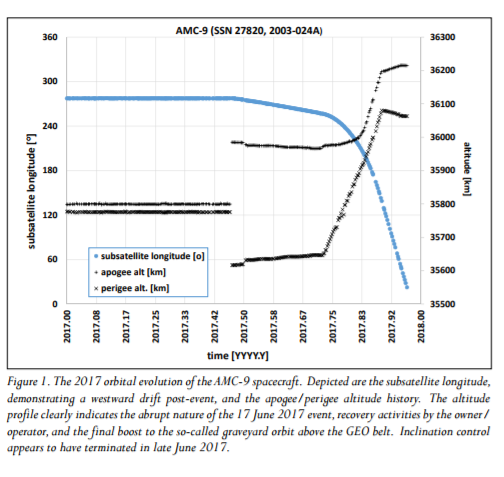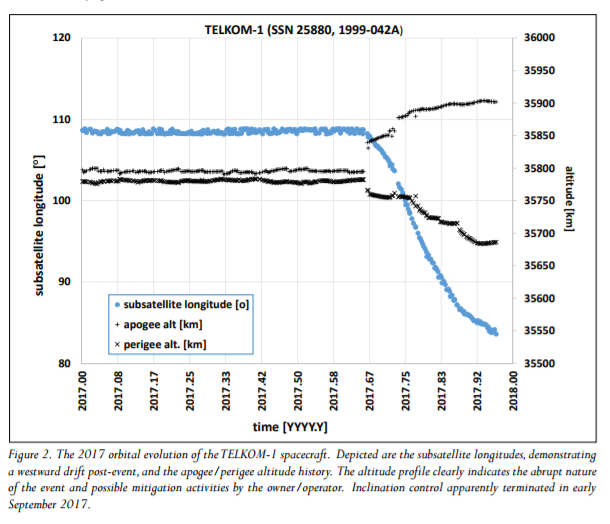This article originally appeared in Orbital Debris Quarterly News, Volume 22, Issue 1, February 2018.
Summer 2017 was marred by two apparently anomalous events in the geosynchronous orbit (GEO) belt. Both incidents have been observed by commercial space situation awareness providers, but as of 26 December 2017 no debris from either event have entered the public catalog.
The GEO communications spacecraft AMC-9 (International Designator 2003-024A, U.S. Strategic Command [USSTRATCOM] Space Surveillance Network [SSN] catalog number 27820), formerly known as GE-12, experienced an energetic event estimated to have occurred at approximately 07:10 GMT on 17 June 2017, after approximately 14 years on-orbit.

Fig. 1 depicts the orbital evolution of the spacecraft in 2017. SES, the spacecraft owner-operator, described this event as a “serious anomaly.” Following this event, the spacecraft began a westward drift in the GEO belt.
Debris fragments have been observed in the vicinity of the AMC-9 spacecraft. SES has regained control of the spacecraft and has transferred AMC-9 to the so-called graveyard orbit, a long-term disposal orbit region located above the GEO belt. The NASA Orbital Debris Program Office (ODPO) characterizes this episode as an anomalous event.
The spacecraft bus is the popular Thales Alenia Space (formerly Alcatel Space) Spacebus-3000B3 platform. Spacecraft dry mass is estimated to be on the order of 2000 kg. On-board stored energy sources include fuel and pressurized components, as well as the battery subsystem.
The Indonesian GEO communications spacecraft TELKOM-1 (1999-042A, SSN catalog number 25880) experienced an energetic event on or about 25 August 2017, after over 18.1 years on-orbit—3 years past its nominal operational lifetime. An examination of the Two Line Element data indicates an observable change in spacecraft orbit between 26 and 29 August.
At the beginning of this time interval, approximately 10:43 GMT on 26 August, TELKOM-1 was in a 35793 x 35781 km, 0.0112° orbit; afterwards, at approximately 19:36 GMT on 29 August, the orbit was 35838 x 35764 km at an inclination of 0.0237°.

PT Telkom, the spacecraft owner-operator, declared on 30 August that the spacecraft could not be salvaged [1]. Following this event, the spacecraft began a westward drift in the GEO belt. As this ODQN goes to press, the spacecraft orbit has evolved as depicted in Fig. 2. The NASA Orbital Debris Program Office (ODPO) characterizes this episode as an anomalous event.
The spacecraft bus is the Lockheed Martin A2100 platform. Spacecraft dry mass is estimated to be on the order of 1640 kg. On-board stored energy sources include fuel and pressurized components as well as the battery subsystem.
Reference 1. “Antenna glitch disconnects Telkom-1 satellite customers in Indonesia,” http:// spacenews.com/antenna-glitch-disconnectstelkom-1-satellite-customers-in-indonesia/ when Figure 2. The 2017 orbital evolution of the TELKOM-1 spacecraft. Depicted are the subsatellite longitudes, demonstrating accessed December 2017.